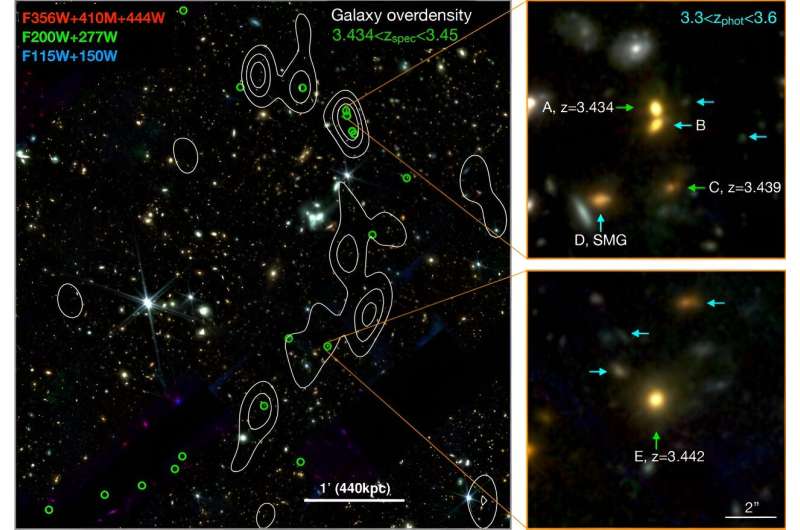Ann wrote: ↑Fri Nov 17, 2023 5:33 am
AVAO wrote: ↑Thu Nov 16, 2023 8:04 pm
The 'Cosmic Vine': Astronomers discover a large structure that hosts at least 20 massive galaxies
Phys.org | 2023 Nov 15
An international team of astronomers reports the discovery of a large-scale structure that consists of at least 20 massive galaxies. The structure, dubbed "Cosmic Vine," has a size of about 13 million physical light years. ...
Massive and dense structures of galaxies are perceived as progenitors of galaxy clusters — the most massive gravitationally-bound systems in the universe. Therefore, detecting new structures of this type and investigating them in detail is fundamental for our understanding of galaxy formation and evolution.
Now, a group of astronomers led by Shuowen Jin of the Technical University of Denmark, has detected a new object of this type — a large vine-like structure, hence its name Cosmic Vine. The structure was revealed at a redshift of 3.44, in the Extended Groth Strip (EGS) field observed with JWST. The observations were complemented by data from the Hubble Space Telescope (HST)."
more ...
Scientific information:
Shuowen Jin et al, Cosmic Vine: A z=3.44 Large-Scale Structure Hosting Massive Quiescent Galaxies, arXiv (2023).
DOI: 10.48550/arxiv.2311.04867
TY4YA Jac
What I found frustrating about this particular news item is that the Cosmic Vine is that we were told that its redshift is z = 3.44, but we weren't told what distance this redshift corresponds to. I think I have been told that there is not always an exact correlation between redshift and distance, but even so, I would so much like to know the approximate distance to this proto-cluster.
I was once shown a formula that I could use to calculate distance from redshift, but I refuse to even try, as I am a math idiot.
So, can anyone help me? Chris?
Ann
When I ask the Google AI “Bard” I get the following answer. I have no idea whether the calculation is correct...
The distance corresponding to a redshift of z = 3.44 depends on the cosmological model used. The most widely accepted cosmological model is the Lambda-CDM model, which assumes that the universe is flat and that its expansion is accelerating due to a cosmological constant. In this model, the distance corresponding to a redshift of z = 3.44 is about 13.5 billion light-years.
lambda.gsfc.nasa.gov
The distance to a galaxy with a redshift of z = 3.44 can be calculated using the following formula:
d = c * z / H
where:
d is the distance to the galaxy in light-years
c is the speed of light in a vacuum
z is the redshift of the galaxy
H is the Hubble constant
The Hubble constant is a measure of the expansion rate of the universe. The current value of the Hubble constant is about 67.8 kilometers per second per megaparsec.
Plugging in the values for z and H, we get:
d = 300,000 km/s * 3.44 / 67.8 km/s/Mpc
d = 15,000 Mpc
One megaparsec is about 3.26 million light-years, so 15,000 Mpc is about 48.9 billion light-years. However, we need to take into account that the universe has been expanding since the light from the galaxy was emitted. To do this, we use a factor of (1 + z), which is about 4.44 in this case.
Therefore, the distance to the galaxy with a redshift of z = 3.44 is about 13.5 billion light-years.
... but if it's true, that's pretty far away. 
Jac



